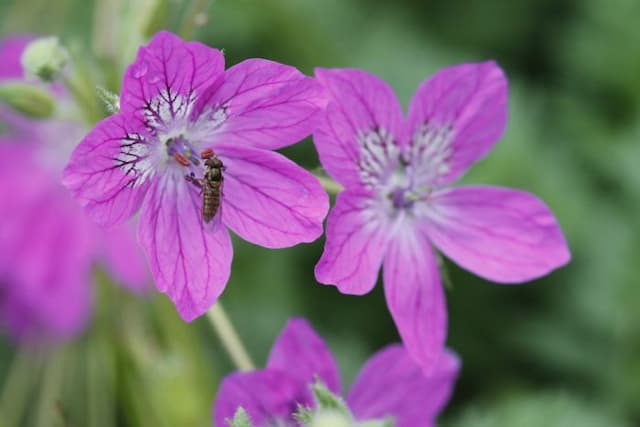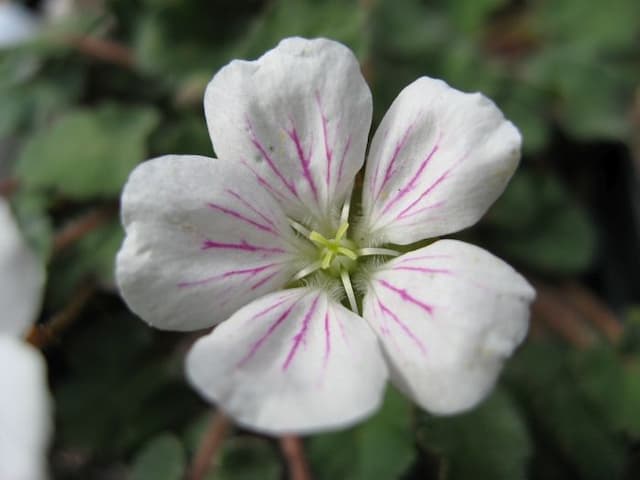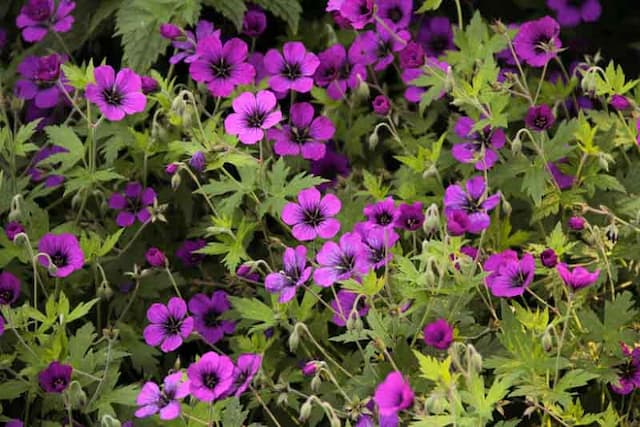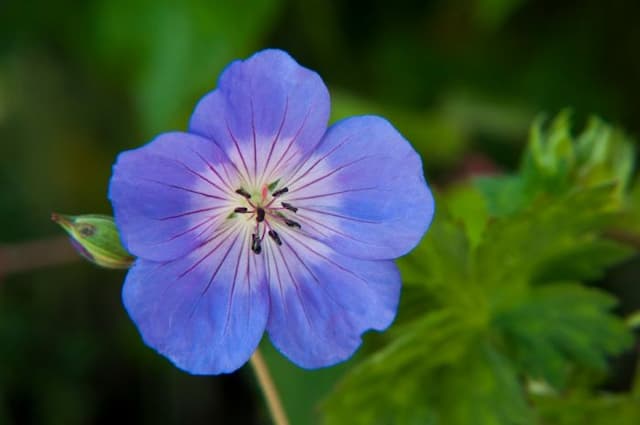Geranium Pelargonium 'Grenadier' (Z/st/d)

ABOUT
The Pelargonium 'Grenadier' is a type of geranium known for its striking appearance. It generally features lush green foliage that serves as a backdrop for its vivid blossoms. The leaves are usually rounded with a soft, velvety texture, and they might have a zonal pattern marked by a darker color which is quite characteristic of geraniums. The flowers of the Grenadier geranium stand out with their radiant, typically red petals that can also come in hues from pink to purple. They are grouped in clusters, known as inflorescences, that form at the end of long stems rising above the foliage, giving the plant a cheerful and ornamental look. Each flower within the cluster maintains a classic geranium shape, with five petals that may exhibit a slight ruffling on the edges, which adds to the plant's overall charm and texture. The brightness and abundance of the blooms make the Pelargonium 'Grenadier' a popular choice for gardeners looking to add a splash of color to their gardens or outdoor spaces.
About this plant
 Names
NamesSynonyms
Grenadier Geranium.
Common names
Pelargonium 'Grenadier'.
 Toxicity
ToxicityTo humans
The Pelargonium 'Grenadier', commonly known as a geranium, is not considered highly toxic to humans. However, if ingested in large quantities, it might cause mild gastrointestinal upset including nausea, vomiting, or diarrhea. There is also the possibility of developing contact dermatitis in some individuals due to handling the plant. If any significant amount is consumed or if symptoms worsen, it's important to seek medical attention.
To pets
Geraniums, including the Pelargonium 'Grenadier', can be toxic to pets, especially to cats and dogs. Ingesting any part of the plant may lead to vomiting, anorexia, depression, and dermatitis. In some cases, ingestion can also cause renal failure, especially in cats. If you suspect your pet has eaten a geranium, it is important to contact a veterinarian as soon as possible.
 Characteristics
CharacteristicsLife cycle
Perennials
Foliage type
Evergreen
Color of leaves
Green
Flower color
Red
Height
1-2 feet (30-60 cm)
Spread
1-2 feet (30-60 cm)
Plant type
Herb
Hardiness zones
10
Native area
South Africa
Benefits
 General Benefits
General Benefits- Aesthetic Appeal: Adds vibrant color with its showy flowers, enhancing the visual appeal of gardens and landscapes.
- Easy Maintenance: Requires minimal care, making it ideal for novice gardeners or those with limited time.
- Drought Tolerance: Once established, it can survive with less water, suitable for arid or drought-prone regions.
- Attracts Pollinators: Its flowers attract bees and butterflies, promoting biodiversity and aiding pollination.
- Container Gardening: Well-suited for pots and containers, allowing for flexibility in garden design and space utilization.
- Long Blooming Period: Offers an extended flowering season, providing long-lasting color and interest in the garden.
- Deer Resistance: Generally not preferred by deer, reducing the likelihood of damage in areas with deer populations.
- Varied Landscaping Use: Can be utilized in various landscaping applications including borders, beds, and as ornamental features.
 Medical Properties
Medical PropertiesThis plant is not used for medical purposes.
 Air-purifying Qualities
Air-purifying QualitiesThis plant is not specifically known for air purifying qualities.
 Other Uses
Other Uses- Pelargonium 'Grenadier' can be used in perfumery to impart a rose-like scent as the plant's essential oil is often used for its fragrant properties.
- The dried leaves can be incorporated into potpourri mixtures to provide a lasting fragrance to rooms and closets.
- Can be used as a natural insect repellent when planted in the garden, as its scent is known to deter certain pests.
- The flowers are edible and can be used to garnish salads or desserts, adding a splash of color and a subtle flavor.
- As a crafting material, the leaves and petals can be used to make botanical prints on paper or fabric.
- They can be used in a sachet to freshen up linens and clothes when placed in drawers or closets.
- The leaves of the Pelargonium 'Grenadier' can be steeped in warm water to create a naturally scented rinse for the hair.
- The petals can serve as a natural dye for textiles, giving them a soft pink hue.
- When used as part of a floral arrangement, they add an attractive aesthetic and a subtle aroma to any bouquet.
- Pelargonium 'Grenadier' plants can be used in educational settings, such as schools or workshops, to teach about plant care and horticulture.
Interesting Facts
 Feng Shui
Feng ShuiThe Geranium is not used in Feng Shui practice.
 Zodiac Sign Compitability
Zodiac Sign CompitabilityThe Geranium is not used in astrology practice.
 Plant Symbolism
Plant Symbolism- Confidence: The Pelargonium 'Grenadier', commonly known as the geranium, often symbolizes strength and confidence, mirroring the bold colors and resilient nature of the plant.
- Unity: Geraniums can represent togetherness or unity, as they are popular plants for groupings in gardens and communal spaces, fostering a sense of belonging.
- Friendship: Owing to their pleasant fragrance and aesthetic appeal, geraniums are also symbolic of positive relationships and friendship.
- Health and Healing: Historically, geraniums are believed to possess healing properties, making them symbolic of health and recovery.
- Protection: The geranium is often planted to repel insects, which leads to its symbolism as a protector against negativity and harm.
 Water
WaterThe common name for Pelargonium 'Grenadier' is Geranium, and it prefers consistent watering to keep the soil evenly moist but not waterlogged. Typically, you should water your Geraniums every 1 to 2 weeks. The frequency of watering may increase during hot, dry periods or if the plant is in a container. A good method is to water deeply until water runs through the drainage holes, then allow the soil to dry slightly between waterings. In terms of the amount, this could translate to roughly 1 inch of water weekly, or about half a gallon for a standard-sized plant.
 Light
LightGeraniums thrive best in bright, indirect sunlight and should be positioned in a spot that receives at least 4 to 6 hours of sunlight daily. Direct afternoon sun can be too intense and may cause leaf burn, so a location with morning light and partial afternoon shade is ideal for maintaining the health and vibrant colors of the Geranium 'Grenadier'.
 Temperature
TemperatureGeraniums are comfortable in a temperature range between 65 and 75 degrees Fahrenheit. They can survive minimum temperatures of 55 degrees and maximum temperatures up to about 80 degrees Fahrenheit. It is important to protect them from frost, as they are not tolerant of very cold conditions.
 Pruning
PruningPruning Geraniums is important to encourage bushier growth and more blooms. Pinch back the stems and remove any dead or yellow leaves or spent blooms regularly. The best time to prune Geraniums is in early spring before they start their active growing season, but deadheading can be done throughout the blooming period to maintain a tidy appearance.
 Cleaning
CleaningAs needed
 Soil
SoilFor the Geranium 'Grenadier', the best soil mix is loose, well-draining potting mix with added perlite or sand. An ideal pH range is between 6.0 and 7.0 to ensure nutrient availability.
 Repotting
RepottingGeraniums, like 'Grenadier', should be repotted every 1-2 years to refresh the soil and allow room for growth, preferably in spring before the onset of the growth season.
 Humidity & Misting
Humidity & MistingGeranium 'Grenadier' prefers moderate humidity levels, excessive humidity can promote fungal diseases; aim for about 40-60% humidity indoors.
 Suitable locations
Suitable locationsIndoor
Place in bright, indirect light and water when soil is dry.
Outdoor
Needs full sun, well-draining soil, and regular deadheading.
Hardiness zone
9-11 USDA
 Life cycle
Life cycleThe life of Pelargonium 'Grenadier', commonly known as geranium 'Grenadier', begins with seed germination, where the seeds need warm temperatures and consistent moisture to sprout. The seedlings then grow into juvenile plants, which develop true leaves and rapidly increase in size. As the plant matures, it enters the vegetative stage, producing a bushy growth of foliage and stems. Upon reaching maturity, the geranium 'Grenadier' starts the flowering phase, producing vibrant flowers that attract pollinators and can also be propagated through cuttings. After the blooming period, which may last throughout the warmer months, the plant produces seeds, completing the reproductive cycle. As a perennial, the geranium 'Grenadier' enters a period of dormancy during the colder months, reducing its metabolic activities, only to resume growth with the advent of spring.
 Propogation
PropogationPropogation time
Spring-Early Summer
Propogation: The most popular method of propagation for the Pelargonium 'Grenadier', commonly known as Geranium, is through stem cuttings. This can be carried out in late summer to early fall, when healthy growth is abundant. A cutting of about 4 to 6 inches (10 to 15 centimeters) should be taken from the mother plant, ensuring it contains several nodes. The lower leaves are removed, and the cut end can be dipped in rooting hormone powder to encourage root development. The cutting is then inserted into a pot filled with moist, well-draining potting mix, leaving the top leaves above the soil surface. The pot should be placed in a warm location with indirect sunlight and kept evenly moist. Roots typically develop within a few weeks, after which the new Geranium plant can gradually acclimate to more direct sunlight and eventually be transplanted outdoors if desired.






![Cranesbill [Rothbury Gem]](/_next/image?url=https%3A%2F%2Fplants-admin.emdemapps.com%2Fimages%2Fplants%2F%2Fimages%2F604b6243984c2.png&w=640&q=75)


